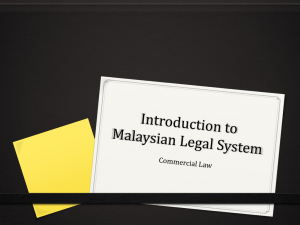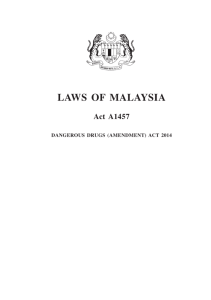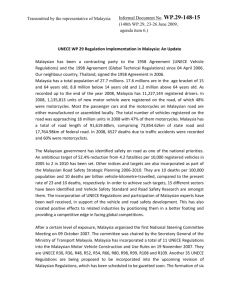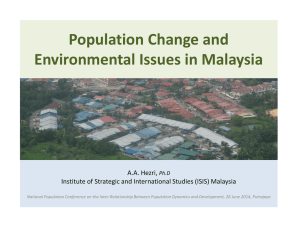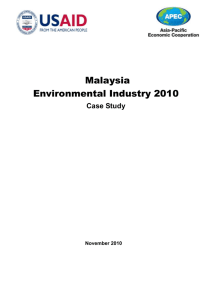Track 1: Asian Judges Network on Environment Updates Since 2010
advertisement
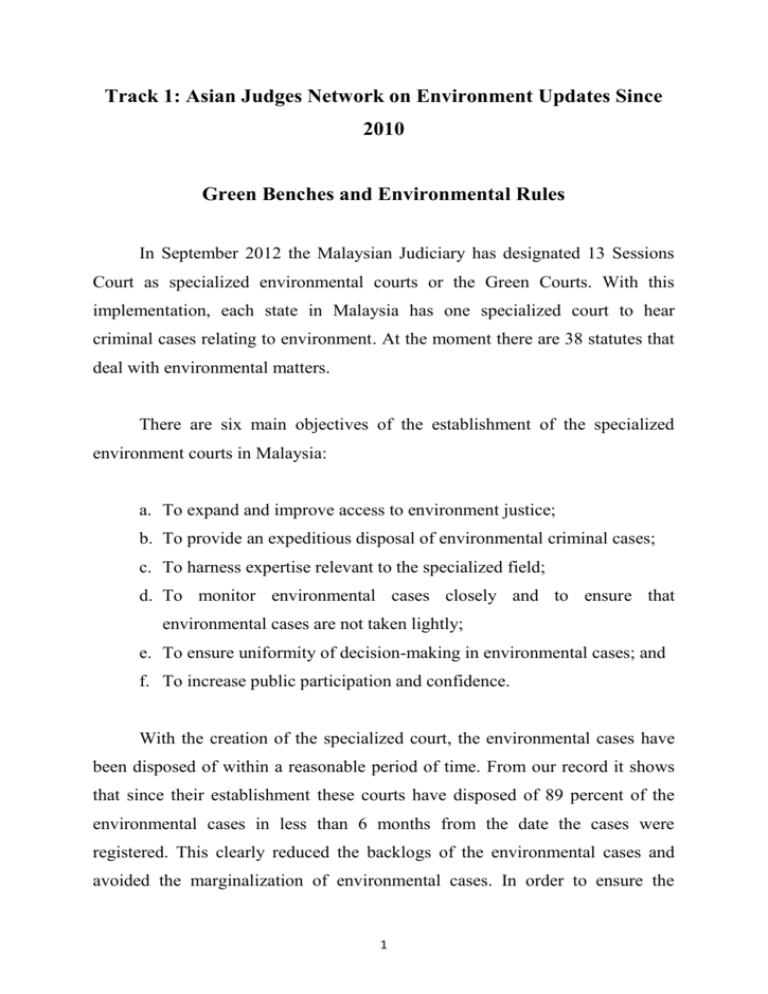
Track 1: Asian Judges Network on Environment Updates Since 2010 Green Benches and Environmental Rules In September 2012 the Malaysian Judiciary has designated 13 Sessions Court as specialized environmental courts or the Green Courts. With this implementation, each state in Malaysia has one specialized court to hear criminal cases relating to environment. At the moment there are 38 statutes that deal with environmental matters. There are six main objectives of the establishment of the specialized environment courts in Malaysia: a. To expand and improve access to environment justice; b. To provide an expeditious disposal of environmental criminal cases; c. To harness expertise relevant to the specialized field; d. To monitor environmental cases closely and to ensure that environmental cases are not taken lightly; e. To ensure uniformity of decision-making in environmental cases; and f. To increase public participation and confidence. With the creation of the specialized court, the environmental cases have been disposed of within a reasonable period of time. From our record it shows that since their establishment these courts have disposed of 89 percent of the environmental cases in less than 6 months from the date the cases were registered. This clearly reduced the backlogs of the environmental cases and avoided the marginalization of environmental cases. In order to ensure the 1 quality of their decisions more experienced judicial officers are appointed to hear environmental cases. At present these officers or the Sessions Court Judges who hear environmental cases have at least 10 years experience in their work. In addition, these officers are required to attend courses and seminars on environmental laws and environment organised by the Judiciary or other relevant department so as to enhance their knowledge and to promote better understanding of issues relating to environment. From September 2012 to October 2013, there were 418 environmental cases registered in the Green Courts throughout the country. From this number 313 cases have been disposed of and as mentioned earlier 89 percent of these cases have been disposed of in less than 6 months. From the information I received, the majority of these cases are offences related to air pollution, pollution of inland waters and discharge of waste which are offences under the Environmental Quality Act 1974. Environmental Rules In Malaysia, many of the sources of environmental law come in the form of written laws and these are laws enacted by the Parliament and the State Legislative Assemblies. Under our Federal Constitution both the federal and state governments are given the powers to deal with environmental matters, both legislatively and administratively. This resulted in the existence of various agencies dealing with various aspects of environment management. This is the main reason for the rather piecemeal approach to environmental legislations in Malaysia. At the moment there are at least 38 environment-related statutes for the purpose of environmental management and conservation. Pursuant to the United Nations Conference on Human Environment in Stockholm in 1972 2 Malaysia introduced its first ever environmental policy directive, which was embodied in the Third Malaysia Plan and enacted a federal statute known as the Environmental Quality Act 1974. This Act relates to the prevention, abatement, control of pollution and enhancement, and for the purpose connected therewith. It is the primary law on pollution control in Malaysia. Since its enactment, the Act was amended several time and these amendment were made because of the changes in Malaysia’s environmental status. Regulations, Rules and orders have continuously been passed under the Act. In 1985 the Act was amended to introduce the environment impact assessment system under section 34A for larger-scale development project due to the growing concern about the destruction of the natural environment by development activities. The 1996 amendment was the most extensive one. This amendment includes: a. The increase in fines and penalties for non-compliance with environmental regulations; b. The prohibition against emission discharge was widened from that of ‘waste’ only to other discharges such as ‘environmentally hazardous substances’ and ‘pollutants’; c. The power given to the Director General to issue a prohibition order to the owner or occupier of any industrial plant or process to prevent its continued operations and release of environmentally hazardous substances, pollutants or wastes; d. The requirements of environment auditing on any vehicles, ships or prescribed premises; e. The establishment of Environmental Fund. One of the purposes of the Fund is to prevent or combat the following occurrences: 3 i. A spillage, discharge or dumping of oil; ii. A discharge, deposit or dumping of environmentally hazardous substances; or iii. A discharge, deposit or dumping of waste. f. The power given to court to order the convicted offender to pay the costs and expenses incurred, or compensation for loss or damage to the property incurred by the victims. The amendment in 2007 involved two separate provisions. The first is the punishment for offences involving scheduled wastes have been increased and the other amendment extended liability to include that of the Chief Executive Officer of a company in addition to the existing liability of company directors. The amendment in 2012 was also comprehensive. It focused on strengthening the management of the environment impact assessment. It also provides for a more proactive enforcement mechanism so that the development projects do not harm the quality of the environment and the health of the people. The amendment also provides the Director General with power to issue stopwork orders on projects that damage the environment, which was previously solely under the minister’s purview. Fines for environmental offences were also increased to a whopping half a million ringgit. Due to the time factor, I do not intend to discuss all the relevant 38 statutes. I will only highlight some other legislations which I consider are also important. The first is the Fisheries Act 1985. It was enacted to consolidate and amend the written law relating to fisheries, including the conservation, management and development of maritime and estuarine fishing and fisheries in Malaysian fisheries waters and to turtles and riverine fishing in Malaysia. The establishment and management of marine parks are provided for under section 4 41 to 45 of the Act. The principal goal of establishing marine parks is to protect, conserve and manage in perpetuity representative marine ecosystem of significant particularly coral reefs and their associated flora and fauna. At the moment there are over 40 islands in Malaysia gazetted under the Act as protected area. The next legislation that needs to be highlighted is the Protection of Wildlife Act 1972 and this Act is applicable to the Peninsular Malaysia only as the States of Sabah and Sarawak have their own legislations on this matter. Under this Act certain land areas can be gazetted as a “wild life reserve” or a “wild life sanctuary” (section 47). Under section 48 it is provided that no person shall enter the areas unless he obtains a written permit from the Director for Wild Life and National Parks. It is also provided that no person shall disturb or cut or remove any timber or vegetation in a wild life reserve. Shooting, killing or taking animal or bird or removing any timber or vegetation in a wild life sanctuary are prohibited under section 49 of the Act. The Act also provides that “totally protected wild animal” or “totally protected wild bird” shall not be shot, killed or taken or be held in possession by any person except special permits are obtained for the purpose. The last legislation which I would like to mention is the National Forestry Act 1984. It was enacted to provide for the administration, management and conservation of forests and forestry development. Under this Act, forest management plan is defined as ‘an operating plan relating to silvicultural, economic or conservation activity or programme prescribed for a particular permanent reserved forest or part thereof to secure the orderly taking, renewal and conservation of trees in accordance with the principle of sustained yield’. The Act authorizes the State Authority to constitute any land a permanent reserved forest and declare that such land shall be ‘permanent reserved forest’. 5 With the determination and concerted effort by the Malaysian Judiciary and the Malaysian Government it is hoped that this would assist in the effort to maintain a healthy environment for human habitation and to slow down the global climate change. Malaysia is working hard to fulfil its obligations under the international conventions and treaties relating to the environment which it has ratified or signed. Prepared by: Justice Dato’ Hasan Lah Federal Court, Malaysia. 6

